Introduction
The Code of Federal Regulations (CFR) is a comprehensive collection of rules established by federal agencies, covering a wide range of sectors such as agriculture, commerce, energy, health, labor, and transportation. Serving as a critical framework for adherence to federal laws, the CFR provides precise instructions for both individuals and organizations. This article explores the history, organization, citations, and accessibility of the CFR, highlighting its dynamic nature and the ongoing efforts to modernize and clarify regulations.
From the role of the Federal Register to the electronic version of the CFR, this informative piece delves into the significance of the CFR in shaping federal regulations and promoting transparency and accountability. Whether you're a legal professional, policymaker, or simply interested in understanding the complexities of federal governance, this article provides valuable insights into the Code of Federal Regulations and its impact on society.
History of the Code of Federal Regulations
The Code of Regulations (CFR), the cornerstone of administrative law, has its roots in the Register Act of 1935. This crucial Act resulted in the establishment of the Register of the Union, presently the everyday diary of the United States government and the main method through which the agencies of the Union communicate with the public. The CFR has since become the ultimate source for the complete and user-friendly presentation of the rules of different government agencies.
Over time, the CFR has adapted to the changing landscape of governance at the national level, with provisions like 'changes without regulatory effect,' also known as Section 100 changes. These adjustments, which include renumbering sections, updating grammar, and striking out obsolete provisions, are made without the full rigmarole of the rulemaking process. They help to simplify the CFR without significantly changing the rights, responsibilities, or obligations under the rules.
The documents available on the Federal Register website are XML renditions of the published works, each accompanied by a link to the corresponding official PDF file, ensuring transparency and accessibility. The Mercatus Center, by means of the testimony of Patrick McLaughlin, has emphasized the intricacy of government rules, which have expanded so extensively that comprehending them could take three years if it were a full-time occupation. This highlights the necessity for computational tools to govern and comprehend the regulatory corpus.
Recent updates to the CFR reflect ongoing efforts to modernize and clarify rules. For example, the Office of Child Support Enforcement proposes to replace the gender-specific term 'paternity' with 'parentage' throughout 45 CFR chapter III, acknowledging the diversity of family structures. Such refinements to policy language are part of the evolving nature of the CFR, ensuring that it remains inclusive and up-to-date with societal shifts.
The effect of government rules is often compared to an 'unseen levy,' as emphasized by Wayne Crews, and the load they impose can have significant economic outcomes. The 2023 version of 'Ten Thousand Commandments' indicates that government rules contribute to a substantial, albeit often unacknowledged, financial burden on the economy. It calls for increased oversight and accountability to mitigate this 'regulatory tax' and enhance economic growth.
As the CFR continues to shape the tapestry of regulations, it is imperative that professionals in the field remain informed about these developments. The ongoing dialogue through public comments and the meticulous review process before finalizing rules ensures that the CFR evolves in a manner that is both responsive to the needs of the public and reflective of the current regulatory climate.
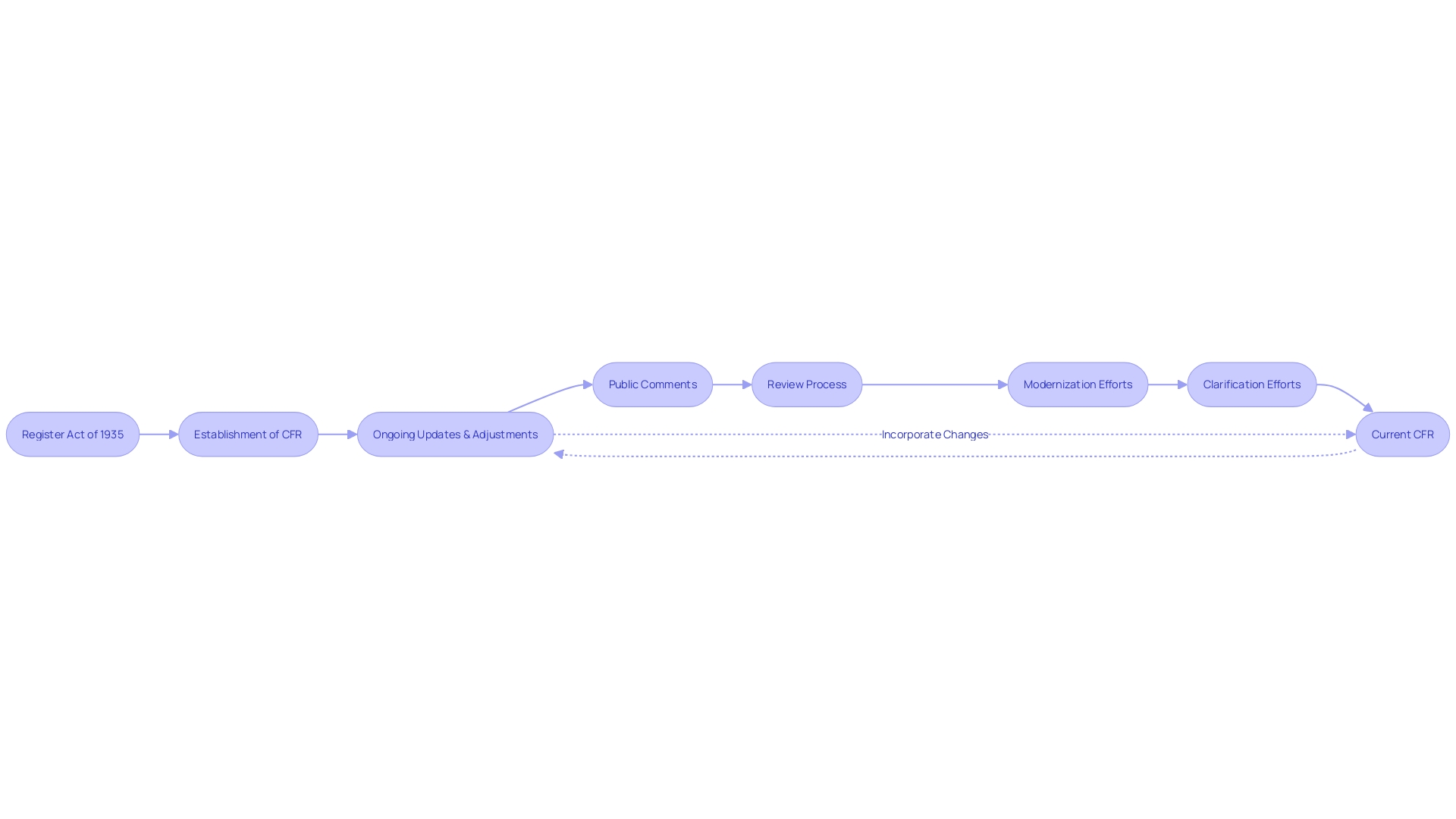
What is the Code of Federal Regulations?
The Code of Regulations (CFR) is an extensive body of rules developed by agencies, encompassing a broad spectrum of areas such as agriculture, commerce, energy, health, labor, and transportation. These rules establish a crucial structure for guaranteeing compliance with federal laws and provide detailed guidance on both individual and organizational behavior. For example, Regulation Z in the CFR outlines requirements for credit card penalty fees, mandating that fees must be proportional to the costs incurred by the issuer for certain account violations, such as late payments or exceeding credit limits. The Consumer Financial Protection Bureau (CFPB) has recently made amendments to this rule, demonstrating the dynamic nature of the CFR in response to evolving financial practices.
The intricacy and sheer amount of the rules contained in the CFR present significant challenges. As mentioned by Patrick McLaughlin of the Mercatus Center, it would require about three years to go through the complete set of federal rules at a speed similar to reading a full-time novel. Such a task highlights the significance of computational tools in overseeing and comprehending these rules. Moreover, the buildup of rules over time has been demonstrated to hinder economic development, underscoring the necessity for ongoing evaluation and modification of current policies.
Public engagement in the rule-making process is also crucial, as seen in recent proposals from the Office of Child Support Enforcement (OCSS), which sought public commentary on replacing the term 'paternity' with 'parentage' in the CFR to reflect inclusive family structures. This highlights the collaborative aspect of improving rules, where input from impacted stakeholders is taken into account in the completion of guidelines.
In the wider framework, rules and guidelines like those in the CFR symbolize a 'secret burden,' as explained by Wayne Crews of the Competitive Enterprise Institute, because of their unquantified financial effects. With federal spending and the national debt reaching staggering levels, the significance of regulations on economic performance becomes even more prominent. Examination of trends and expenses highlights the need for openness and accountability in the process of regulation by Congress.
Essentially, the CFR is a living document, reflective of the state's ongoing efforts to balance the objectives of governance with the operational realities of various sectors, and it remains integral to the functioning of a society governed by the rule of law, as rooted in historical precedents like the Magna Carta.
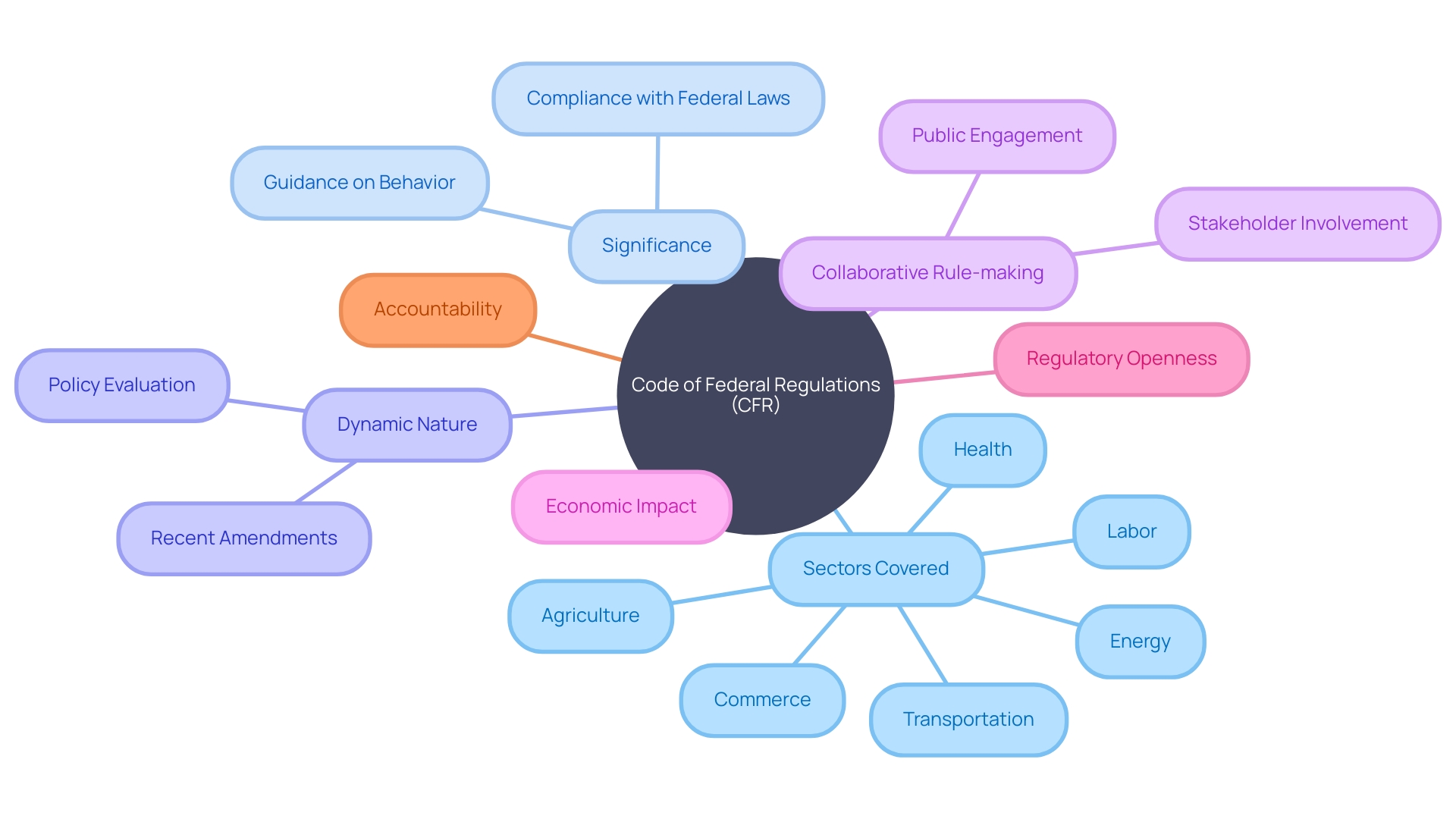
How is the CFR Organized?
The Code of Federal Regulations (CFR) is systematically arranged into 50 distinct titles, each encompassing a wide area of regulatory authority. For specificity and ease of reference, these titles are meticulously subdivided into chapters, subchapters, parts, sections, and even further to subsections. This complex framework helps users in identifying rules with accuracy. Every title is directly connected to a government agency or a group of associated agencies, assigned with the implementation and enforcement of rules within their respective area of influence. For instance, recent amendments in Regulation Z under Title 12 by The Consumer Financial Protection Bureau (CFPB) demonstrate the ongoing evolution of the CFR, as they address credit card penalty fees to align with the cost analysis provisions or comply with established safe harbor conditions.
Furthermore, the CFR's usefulness is apparent in its role as a living document, subject to ongoing updates and revisions, reflecting the dynamic nature of regulatory practices. An example of such revisions includes the Federal Register's corrections to the application of pluralization in certain FDA rules, ensuring consistency and clarity. The CFR's adaptability is also seen in the proposed rule changes soliciting public comments, like those made by the Office of Child Support Enforcement (OCSS), which proposed replacing 'paternity' with 'parentage' throughout 45 CFR chapter III, to embrace all family structures within the child support services program.
The significant impact of regulations imposed by the government, often compared to a 'hidden tax', is revealed by experts like Wayne Crews. In the 2023 edition of Ten Thousand Commandments, Crews highlights the substantial, yet frequently disregarded, financial influence of the government rule-making system. The report emphasizes the necessity for greater scrutiny, transparency, and accountability of both new and existing governmental mandates.
The combined impacts of administrative actions can be significant, as demonstrated by a week of rulemakings in August 2024, which resulted in $15.5 billion in total cost savings despite adding over 380,000 annual paperwork burden hours. Among these, the FTC's final rule on the use of consumer reviews and testimonials significantly contributed to the week's net-savings trend. The CFR, therefore, functions not only as a repository of rules but also as an indicator of the federal government's efforts to balance the impacts of governmental controls on society.
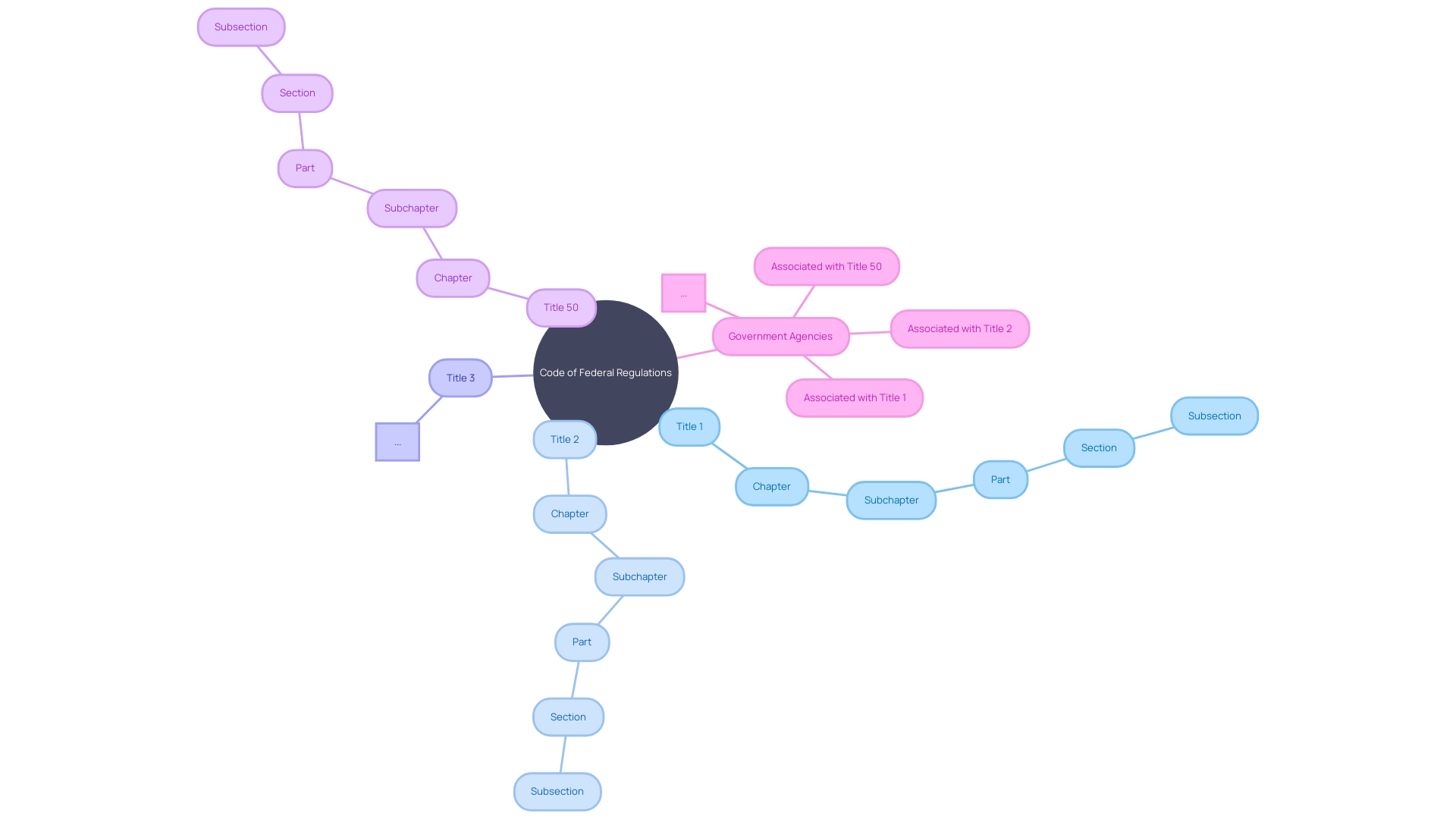
Structure of a CFR Citation
When citing regulations from the Code of Federal Regulations (CFR), it is essential to follow a precise format that includes several key elements. This allows users to quickly locate and accurately reference the information they need. A standard CFR citation includes the title number, a condensed form of the title, the part number, the specific section number, and the year of publication. To illustrate, a reference such as '21 CFR 101.3 (2021)' breaks down as follows: '21' is the title number, 'CFR' is the abbreviation for the Code of Federal Regulations, '101' is the part number, '3' is the section number, and '2021' is the year of publication. This format ensures consistency and reliability, which is particularly crucial in legal contexts where the precision of information can significantly impact judicial decisions and legal outcomes.
Update Schedule for CFR Volumes
Maintaining adherence to the constantly changing legal landscape is crucial, and the Code of Federal Regulations (CFR) is an essential resource for keeping up with these modifications. The CFR is rigorously updated to incorporate new rules, modifications, and overhauls that are essential for compliance. This ongoing process is managed through annual revisions of each title, with updates released in multiple volumes at different times throughout the year. This systematic update schedule is crucial for ensuring the CFR's content is reflective of the most recent regulatory developments. Therefore, it is crucial for individuals and entities to consult the most recent edition of the CFR to ensure compliance with current rules. The publication of the 'eCFR' or 'Electronic Code of Federal Regulations' has been instrumental in this regard, providing a user-friendly, accessible format. Its design, with paragraphs logically split and indented, is intended to mirror the official document's structure. This makes it easier to navigate and understand, all while maintaining the original purpose of the rules. Using the eCFR as a tool can greatly assist in the understanding and application of requirements.
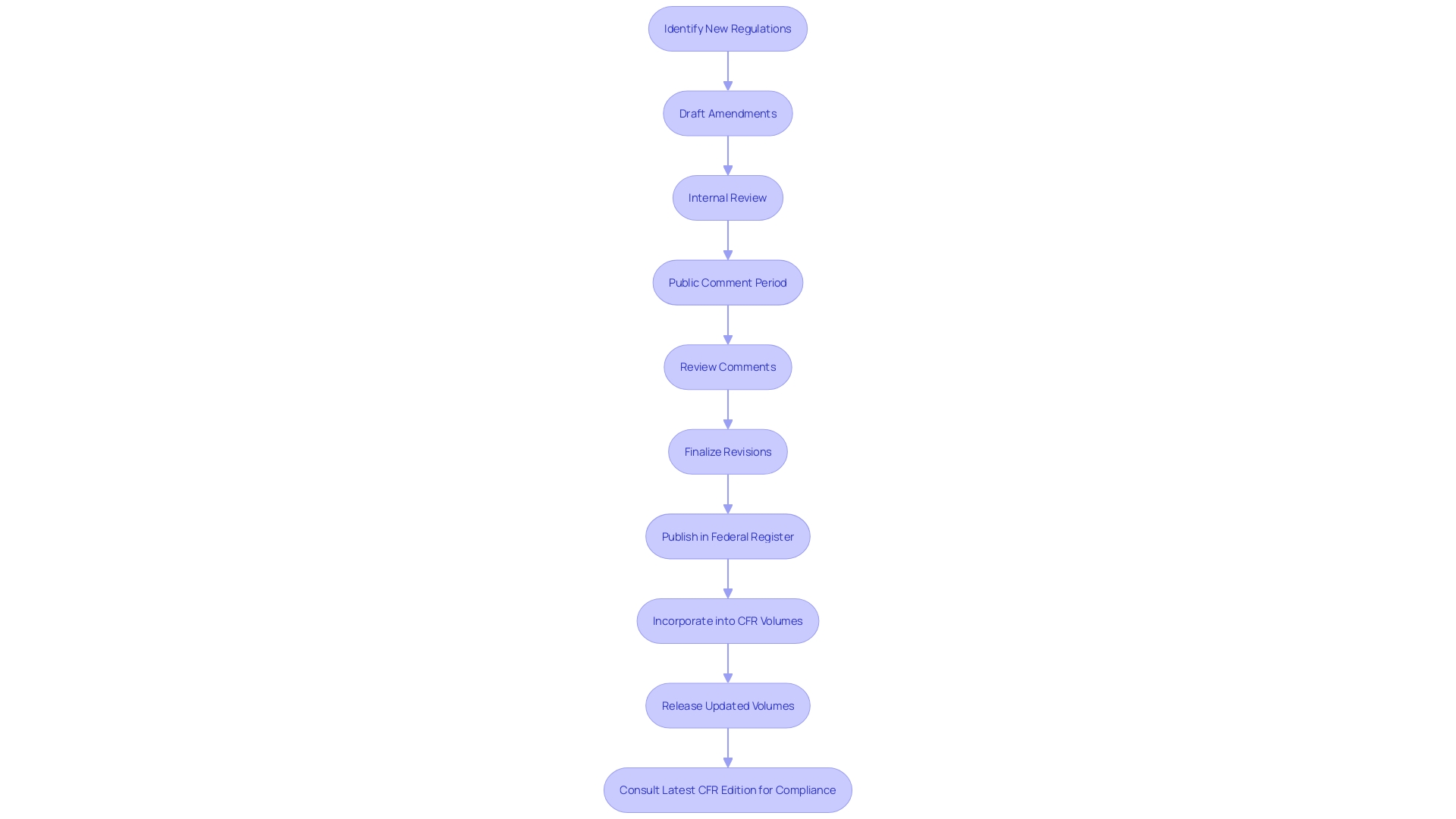
Online Availability and Access
Access to the Code of Federal Regulations (CFR) is streamlined through both government and private sector online platforms. Through the Government Publishing Office's (GPO) official website, users can effortlessly search, browse, and download regulations at no cost, making this resource both practical and accessible. The electronic Code of Federal Regulations (eCFR) is particularly user-friendly, providing a layout where paragraphs are split and indented to mirror the document's hierarchical structure, simplifying the navigation process. Additionally, for Federal agency employees involved in drafting regulations, resources are available that match the official CFR formatting, thus supporting accuracy and adherence to agency intent. Private commercial platforms also contribute by offering advanced tools that enhance the research experience, allowing users to delve into the CFR with greater ease. These platforms are designed to handle the complexities of government functions, whether it's the Federal Aviation Administration's responsibilities in space traffic management or the Federal Communications Commission's role in space-related communications. As the digitalization of government services continues to evolve, forums such as the CX Imperative Forum encourage the exchange of innovative solutions for digital governance. Additionally, programs like the California Appellate Advocacy Program at UC Law San Francisco underscore the value of these resources by providing attorneys with opportunities to refine their arguments before the California Supreme Court. For those seeking comprehensive legal documents, such as the Supreme Court of Israel's rulings, these too are readily available online. The integration of established, non-discretionary methods within these platforms ensures that users can confidently engage with the content, knowing that the terms of any interaction or transaction are clearly defined and agreed upon. This commitment to transparency and functionality reflects the broader efforts, as seen in the United Nations' e-Government Knowledgebase, to enhance access to information and foster citizen participation across member states.
The Role of the Federal Register in CFR
The Federal Register plays a crucial role in the process of governing, serving as the official daily record for rules, proposals, and legal notices from government entities. This transparency not only enables stakeholders to review and comment on changes but also plays a critical part in the democratic process by facilitating public participation in shaping federal policies. Upon reaching finalization, a rule is codified into the CFR, seamlessly integrating into the nation's framework of regulations. For example, recent changes to FDA rules demonstrate careful focus on specifics, like the clarification on pluralizing and the precise connection of data elements for easier traceability. These updates, published in the Federal Register, exemplify the ongoing efforts to improve and enhance texts for clarity and coherence.
The importance of these publications is further emphasized by the Biden-Harris Administration's dedication to enhancing American lives through rules, as emphasized by Sam Berger of the Office of Information and Regulatory Affairs. The administration's agenda, published in the Federal Register, outlines forthcoming and recently completed actions, signaling a strong focus on public engagement in the development of regulations.
Moreover, the Federal Register's role extends beyond notification; it serves as a cornerstone for legal and judicial notice. For instance, recent USDA rules aim to improve transparency in the poultry industry by mandating integrators to disclose detailed operational and economic information to growers, addressing information asymmetries that have historically impacted growers' decision-making and risk management. These rules also require the maintenance of comprehensive records, with an estimated compliance cost of approximately $11.3 million over a decade.
Such careful documentation and revision processes, together with the administration's broader regulatory efforts, strengthen the significance of the Federal Register as a crucial instrument in the development of government rules and the advancement of administrative transparency.
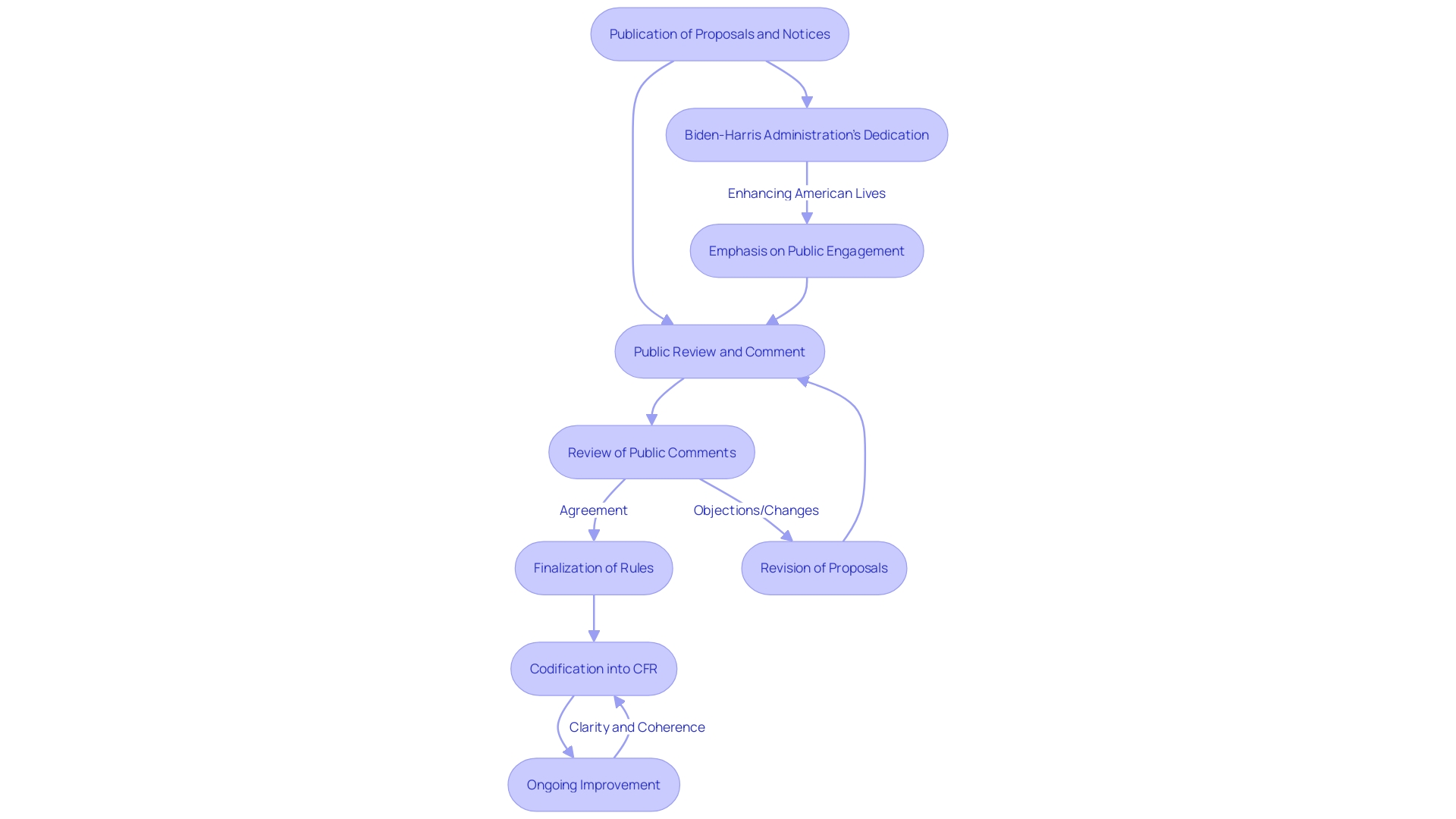
Electronic Code of Federal Regulations (e-CFR)
The Electronic Code of Federal Regulations (e-CFR) is an intuitively designed, regularly updated digital resource that serves as a reliable and current source of federal rules. It improves user experience by providing a well-organized display of the rules with paragraphs indented and divided to reflect the structure of the document, making navigation and understanding easier. The e-CFR's advanced search engine, along with hyperlinks and cross-references, simplifies the process of finding relevant rules and comprehending their interconnections. Notably, the design changes implemented, such as the use of standard text styles and increased line spacing, aim to improve readability without altering the intent of the agencies. The e-CFR's automated updates and formatting are designed to assist users from various sectors, including federal agencies crafting policies, by presenting the CFR in an accessible and actionable format.
Use of '[Reserved]' in the CFR
The term '[Reserved]' in the Code of Federal Regulations (CFR) serves a specific purpose, denoting that a section or part is presently unoccupied but may be filled with content in the future. Such placeholders are common in texts related to rules and mandates, indicating that while no guidelines or mandates are currently assigned to that area, it is available for potential mandates. The presence of '[Reserved]' is not an error but a formal indication of the potential for future rulemaking or amendments. Comprehending this term and its implications is vital for staying up to date with potential changes in requirements that could affect the compliance status of medical devices, especially those undergoing the FDA's 510k clearance process, which the majority of human medical devices are subject to.
Parallel Table of Authorities and Rules
The Parallel Table of Authorities and Rules serves as a pivotal reference guide, aligning the sections of the Code of Federal Regulations (CFR) with their respective authorizing statutes within the United States Code (USC). This alignment is crucial as the USC is the codification of federal statutes enacted by Congress, while the CFR is the collection of rules and guidelines that federal agencies create to enforce these statutes. The table ensures that there is clear traceability between the laws passed by Congress (USC) and the implementing regulations (CFR), facilitating legal compliance and oversight. It enables researchers and legal professionals to effectively locate the statutory basis behind specific provisions, ensuring a comprehensive understanding of the legal framework governing compliance. Moreover, the Parallel Table of Authorities and Rules is a testament to the intricate system of checks and balances that upholds the rule of law in the United States, providing a systematic method for monitoring the correlation between legislative intent and regulatory action.
Conclusion
In conclusion, the Code of Federal Regulations (CFR) is a crucial collection of rules established by federal agencies, providing precise instructions for individuals and organizations to adhere to federal laws. The CFR, originating from the Federal Register Act of 1935, has become the definitive source for presenting regulations from various federal agencies.
Organized into 50 titles, the CFR is a dynamic document that adapts to the changing regulatory landscape through provisions like Section 100 changes. Citing regulations from the CFR follows a precise format, ensuring consistency and reliability in legal contexts. The CFR is regularly updated through multiple volumes released throughout the year, with the electronic version, eCFR, offering a user-friendly format.
Access to the CFR is facilitated through government and private sector online platforms, providing practical and comprehensive resources. The Federal Register serves as the official daily record for regulatory changes, enabling public participation and integration of regulations into the CFR. The eCFR enhances user experience with its structured presentation and advanced search engine.
The CFR's significance extends beyond notification, serving as a cornerstone for legal and judicial notice. The Parallel Table of Authorities and Rules aligns the CFR with the United States Code, ensuring traceability between statutes and regulations.
Overall, the CFR's ongoing evolution and accessibility contribute to the functioning of a society governed by the rule of law, promoting transparency and accountability in federal governance.




